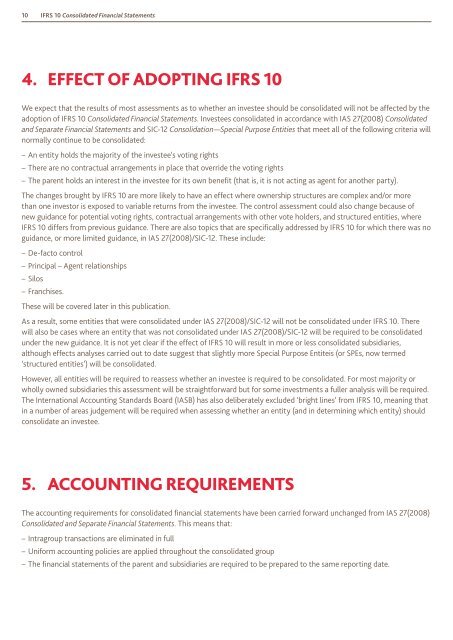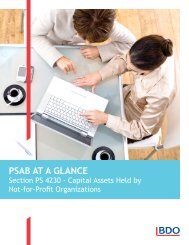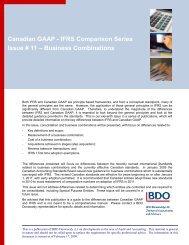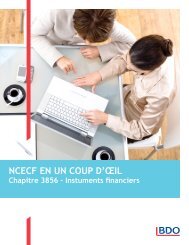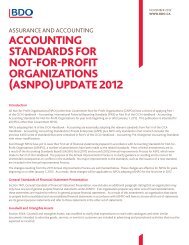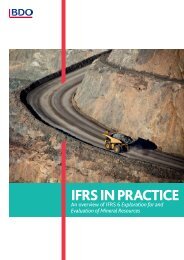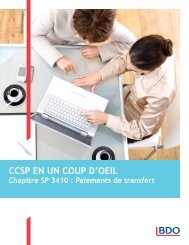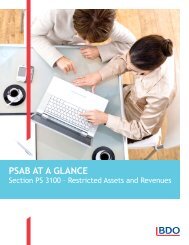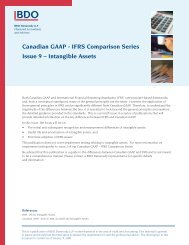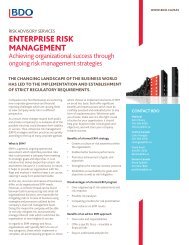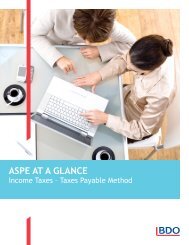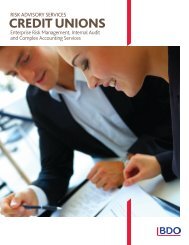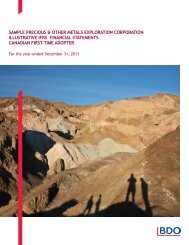Need to Know: IFRS 10 - Consolidated Financial ... - BDO Canada
Need to Know: IFRS 10 - Consolidated Financial ... - BDO Canada
Need to Know: IFRS 10 - Consolidated Financial ... - BDO Canada
- No tags were found...
Create successful ePaper yourself
Turn your PDF publications into a flip-book with our unique Google optimized e-Paper software.
<strong>10</strong> <strong>IFRS</strong> <strong>10</strong> <strong>Consolidated</strong> <strong>Financial</strong> Statements4. Effect of adopting <strong>IFRS</strong> <strong>10</strong>We expect that the results of most assessments as <strong>to</strong> whether an investee should be consolidated will not be affected by theadoption of <strong>IFRS</strong> <strong>10</strong> <strong>Consolidated</strong> <strong>Financial</strong> Statements. Investees consolidated in accordance with IAS 27(2008) <strong>Consolidated</strong>and Separate <strong>Financial</strong> Statements and SIC-12 Consolidation—Special Purpose Entities that meet all of the following criteria willnormally continue <strong>to</strong> be consolidated:––An entity holds the majority of the investee’s voting rights––There are no contractual arrangements in place that override the voting rights––The parent holds an interest in the investee for its own benefit (that is, it is not acting as agent for another party).The changes brought by <strong>IFRS</strong> <strong>10</strong> are more likely <strong>to</strong> have an effect where ownership structures are complex and/or morethan one inves<strong>to</strong>r is exposed <strong>to</strong> variable returns from the investee. The control assessment could also change because ofnew guidance for potential voting rights, contractual arrangements with other vote holders, and structured entities, where<strong>IFRS</strong> <strong>10</strong> differs from previous guidance. There are also <strong>to</strong>pics that are specifically addressed by <strong>IFRS</strong> <strong>10</strong> for which there was noguidance, or more limited guidance, in IAS 27(2008)/SIC-12. These include:––De-fac<strong>to</strong> control––Principal – Agent relationships––Silos––Franchises.These will be covered later in this publication.As a result, some entities that were consolidated under IAS 27(2008)/SIC-12 will not be consolidated under <strong>IFRS</strong> <strong>10</strong>. Therewill also be cases where an entity that was not consolidated under IAS 27(2008)/SIC-12 will be required <strong>to</strong> be consolidatedunder the new guidance. It is not yet clear if the effect of <strong>IFRS</strong> <strong>10</strong> will result in more or less consolidated subsidiaries,although effects analyses carried out <strong>to</strong> date suggest that slightly more Special Purpose Entiteis (or SPEs, now termed‘structured entities’) will be consolidated.However, all entities will be required <strong>to</strong> reassess whether an investee is required <strong>to</strong> be consolidated. For most majority orwholly owned subsidiaries this assessment will be straightforward but for some investments a fuller analysis will be required.The International Accounting Standards Board (IASB) has also deliberately excluded ‘bright lines’ from <strong>IFRS</strong> <strong>10</strong>, meaning thatin a number of areas judgement will be required when assessing whether an entity (and in determining which entity) shouldconsolidate an investee.5. Accounting requirementsThe accounting requirements for consolidated financial statements have been carried forward unchanged from IAS 27(2008)<strong>Consolidated</strong> and Separate <strong>Financial</strong> Statements. This means that:––Intragroup transactions are eliminated in full––Uniform accounting policies are applied throughout the consolidated group––The financial statements of the parent and subsidiaries are required <strong>to</strong> be prepared <strong>to</strong> the same reporting date.


